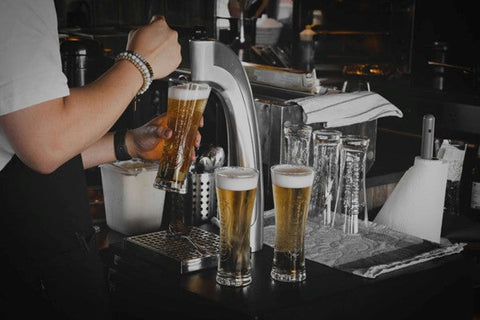When we think of beer, many of us have a favourite of that which is poured from a tap or that which comes from a can or bottle. Beer on draught (or “draft” in the U.S.) is poured from a keg via a tap system, which has some aesthetic advantages (i.e. the foamy head). However, the differences include more than just presentation. Let’s explore the contrasts between draught and packaged beer (plus a little dive into the debate of cans vs. bottles), and dispel the myth that craft beer cannot be draught beer.
What’s Special About Draught Beer?
Draught typically refers to beer served from a keg or cask via a tap system, rather than in a sealed bottle or can.
![]()
![]()
Freshness & Exposure to Light/Oxygen
One of the principal advantages of draught beer is that it is often fresher; less time has elapsed between brewery and consumption, and the keg system can limit exposure to oxygen and light (both of which degrade beer flavour over time).
When beer is bottled or canned, it undergoes packaging, potentially filtering or pasteurisation, then sits in distribution, storage, and retail environments. During that time, trace oxygen ingress, light (especially through clear or green bottles), or temperature fluctuations can soften hop aromas or introduce stale/off notes.
In contrast, a well-maintained draught line (keg, to gas, to tap) can present beer in a state closer to how it left the brewery.
Use of Gases & Pressure Systems
What’s also important is how draught beer is delivered. Keg systems commonly use carbon dioxide or mixed gas (with nitrogen) to push the beer out and maintain carbonation. The pressure settings, gas purity, and line length all influence how the pour looks, how much foam forms, and how the beer’s mouthfeel is experienced.
In some speciality systems, nitrogen is used to generate smaller bubbles and a creamier texture (you often hear of “nitro” pours). Guinness is the classic example: its signature smooth, creamy texture owes to the use of nitrogen and specialised dispensing.
Because the gas system is integrated, draught beer can maintain stable carbonation and minimise oxidation during dispensing; advantages that are not always present once beer is bottled or canned and stored for some time.
Serving Temperature, Mouthfeel & Pouring
Draught systems typically chill the beer close to the point of dispense, which helps ensure a consistent serving temperature and is another factor in perceived freshness and crispness.
Also, the act of pouring into a glass (rather than just drinking from a container) allows aromas to open, and for you to see the head formation, which helps to enhance the sensory experience.
That being said, draught is not fool-proof; if the lines aren’t cleaned, or the gas mix or pressure is off, flavour can suffer. So hygiene and maintenance are critical.

Craft Beer: Not Just Cans and Bottles
A common misconception among casual drinkers is that craft beer is primarily (or only) packaged in cans or bottles. In fact, many craft breweries offer their beers on draught in taprooms, bars, pubs, festivals, or dedicated brewpubs.
The assumption probably comes from the visibility and convenience of packaged beer; cans and bottles are shelf-stable, distributable, and available in stores, making them more familiar to many people. But craft beers are absolutely offered on draught, especially in local beer bars and brewery taprooms.
So when you visit a craft brewery or beer bar, don’t assume there’s nothing on tap, in fact it could be the case that some of their beers may only be available via draught!

Cans vs. Bottles: What’s the Difference?
Moving away from draught, the two main packaged formats are cans (aluminium) and bottles (glass). Each come with trade-offs in flavour preservation, sustainability, portability, and cost.

Flavour Preservation & Shelf Life
One of the ongoing debates in beer circles is whether cans or bottles better preserve flavour over time. Science suggests that beer begins to change the moment it is packaged, and container choice influences how fast that change happens.
Because aluminum cans are opaque and block all light, plus provide a near‐airtight seal, they offer strong protection from UV and light damage, which is a known cause of ‘skunking’ in beers with hops.
Bottles, especially with clear or green glass, are more vulnerable to light exposure; brown bottles help mitigate that, though not perfectly.
One advantage of glass is that it is chemically inert (i.e. it doesn’t interact with the beer), which is a strength as it doesn’t impart flavours. Although, modern cans do use interior linings to prevent metallic interaction.
Interestingly, research shows that the ‘best’ container may depend on beer style: one study found that an amber ale remained fresher in bottles, whereas for some IPAs the difference between can and bottle was less pronounced.
So the simple claim that ‘cans are always better’ or ‘bottles are always better’ is too reductive; but in many typical scenarios, cans lend themselves to better long-term stability of aromas and flavours, as well as protection from light and oxygen.

Environmental & Sustainability Considerations
From a sustainability standpoint however, cans generally come out ahead for the following reasons:
-
Aluminum can be recycled again and again without losing quality, and the recycling process tends to use less energy compared to producing new aluminum.
- Cans are lighter and more compact, therefore transportation tends to have a lower carbon footprint (less fuel used for shipping heavy glass bottles).
That being said, glass is highly recyclable, and in well-managed systems, bottles can also be environmentally competitive; particularly if reused, or if the supply chain is local.
So while aluminum cans often hold the advantage, the full environmental picture depends on local recycling infrastructure, transport distances, and reuse.

Portability, Cost & Practicalities
Cans are lighter, more robust (won’t shatter), chill faster, and are easier to stack, which create advantages in transport, storage, and on-the-go consumption.
While a glass bottle may feel more special to some drinkers, the practical downsides are fragility, heavier shipping costs, and restrictions (for example many public outdoor venues ban glass).
In terms of cost, the shipping burden of glass often adds to price, whereas cans’ lighter weight and more efficient logistics can reduce overheads.

To Sum Up
At the end of the day, choosing between draught, canned, or bottled beer comes down to what you value most in the drinking experience. Draught beer often stands out for its freshness, vibrant flavours, and the unique texture created by carefully balanced gas systems, although this depends heavily on how well the tap lines are maintained. Meanwhile, remember that craft beer isn’t confined to the shelves of retailers in cans or bottles; many of the most exciting and experimental brews are poured straight from the tap in breweries and bars.
When it comes to packaged beer, the choice between cans and bottles is more nuanced than it might seem. Cans offer strong protection against light and oxygen, tend to preserve hop character for longer, and are generally considered the more environmentally friendly option thanks to their lighter weight and recyclability. Bottles, on the other hand, carry a sense of tradition and elegance, and their inert glass provides a clean vessel for many beer styles, though they’re heavier and more fragile.
Ultimately, the ‘best’ way of drinking beer isn’t universal; it depends on the style of beer, how it’s stored, and how you plan to enjoy it. Whether you’re savouring a pint at your local pub, cracking open a can on a hike, or pouring a bottled ale at home, each format has its place in the wider world of beer.







